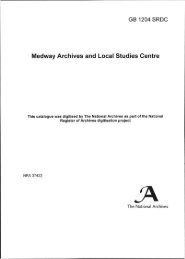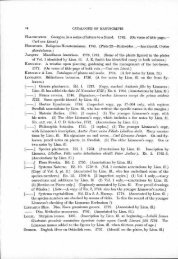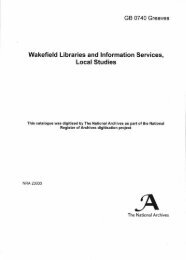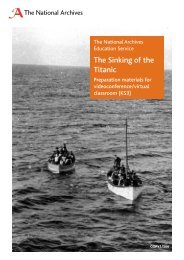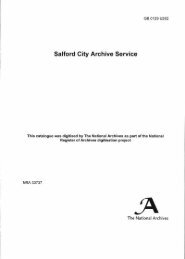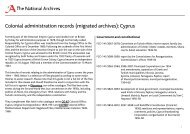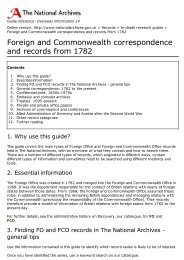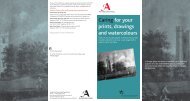link to scanned list part 1 - The National Archives
link to scanned list part 1 - The National Archives
link to scanned list part 1 - The National Archives
You also want an ePaper? Increase the reach of your titles
YUMPU automatically turns print PDFs into web optimized ePapers that Google loves.
CH.108<br />
Perhaps unkindly and misleadingly, Keevil describes Hawkins' action in founding his Hospital as<br />
"the dying echo of the age of pity" (vol.1 p.52).<br />
In terms of civil legislation, Queen Elizabeth did enable the enacting of laws <strong>to</strong> relieve suffering<br />
among Mariners in the period from 1593 but apparently with little effect (Black p.p. 264-265).<br />
Ultimately better universal poor relief was enabled by the great Elizabethan Poor Laws of 1598 and<br />
1601 although even these worked imperfectly due <strong>to</strong> inequality in Parish finances from place <strong>to</strong><br />
place.<br />
<strong>The</strong> momen<strong>to</strong>us national event which inspired Hawkins' Hospital was the Spanish Armada of<br />
1588. For the first time in English his<strong>to</strong>ry probably, large numbers of seamen were paid-off,<br />
many maimed, ill and destitute. When it became apparent that the Spanish Armada had sailed in<strong>to</strong><br />
the North Sea, the English Fleet had anchored off Margate. Here nearly all crews were<br />
disembarked, leaving only skele<strong>to</strong>n crews <strong>to</strong> sail the Fleet in<strong>to</strong> Chatham.<br />
<strong>The</strong> Kent seaside <strong>to</strong>wns were affected by a sudden influx of these seamen. Lord Howard of<br />
Effingham, the Fleets Commander, grieved "<strong>to</strong> see them that have served so valiantly die so<br />
miserably". Holden asserts in fact that Effingham was the prime mover behind the Chatham<br />
Chest. If this was so, Hawkins may have wanted <strong>to</strong> make his own contribution <strong>to</strong> Naval charity.<br />
<strong>The</strong> Local His<strong>to</strong>rical Context<br />
For several centuries Rochester and Chatham had benefited from St. Bartholomew^ Hospital,<br />
founded as a Leper Hospital in the late eleventh century and reputedly the country's oldest Hospital<br />
(see collection CH2 at this Centre). <strong>The</strong> res<strong>to</strong>red Norman Chapel of St. Bartholomew^ Hospital<br />
stands opposite Hawkins' Hospital.<br />
Immediately prior <strong>to</strong> Hawkins' foundation of his Hospital, Richard Watts, the builder of Upnor<br />
Castle founded his Charity and Almshouse in Rochester, in 1579 (see collection CH46 also at this<br />
Centre). This being the case, the echo referred <strong>to</strong> by Keevil was certainly louder and more<br />
persistent in the Medway Towns.<br />
Reinforcing these developments, William Brook, 10th Lord Cobham in 1598 adapted an existing<br />
chantry house at Cobham <strong>to</strong> serve as an Almshouse known as Cobham College. (<strong>The</strong> records of<br />
Cobham College are held by the Rochester Bridge Wardens at Bridge Chamber, Esplanade,<br />
Rochester. <strong>The</strong> Cobham Parish and Darnley of Cobham Hall family and estate records are held at<br />
this Centre, collections P96 and U565 respectively).<br />
In fact, probably contrary <strong>to</strong> KeeviFs argument, Hawkins' Hospital was very significant as a<br />
sixteenth century charity. In the long term, Hawkins had been encouraged by a period of growth<br />
in secular charitable foundations originally caused by the collapse of monastic almsgiving<br />
following the Protestant Reformation in religion in Henry VIIFs reign.* <strong>The</strong> secular response <strong>to</strong><br />
this in the second and third quarters of the sixteenth century coincided with a revival of religious<br />
and economic confidence, exemplified by Watts and Lord Cobham locally, besides Hawkins,<br />
himself a merchant. As an almshouse his<strong>to</strong>rian puts it, "the reign of Elizabeth had run half its<br />
course before major private benefactions began <strong>to</strong> appear again as a result of more settled times<br />
and policies" (Bailey p.90).<br />
Finally, it may be significant that John Whitgift, Archbishop of Canterbury was one of the first<br />
Governors of Hawkins' Hospital. Regarding Whitgift, Bailey states "the first ecclesiastical<br />
foundation of real importance after the Reformation was John Whitgift's Hospital at Croydon<br />
[Surrey] in 1598" (p.95). Hawkins' Hospital therefore had as its most eminent early Governor, an<br />
ecclesiastical statesman who was at the forefront of charity in his age.<br />
* Held at this Centre are the records of St. Andrew's Priory, Rochester, and several<br />
other Kent monastic foundations closed by Henry VHI (see collection DRC).<br />
pcl5/env/john-haw.sd (nf/msm)




